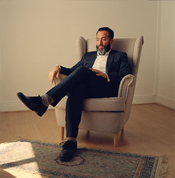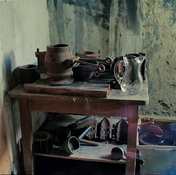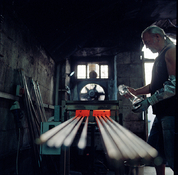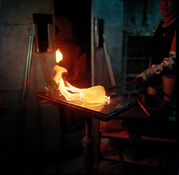- Home
- Forums
- Analog Workflow Forums (100% Analog/Traditional)
- Darkroom
- Color: Film, Paper, and Chemistry
You are using an out of date browser. It may not display this or other websites correctly.
You should upgrade or use an alternative browser.
You should upgrade or use an alternative browser.
Portra 160 or Ektar 100 - latitude in highlights - interiors photography
-
A
- Thread starter sperera
- Start date
Recent Classifieds
-
For Sale Fuji fp3000b & Fp100c fridgestored
- Started by belichten
-
For Sale Beautiful Tenba Messenger Bag
- Started by chuckroast
-
Want to Buy Shen Hao TFC617 A or B
- Started by djdister
Forum statistics
BrianShaw
Member
I'm kind of talking myself into the corner I wanted to be at really....Portra is my love....in all flavours.....that being said, again, highlight rendition is what I am focusing on.....
It seems like the correct corner! I hope this thread is helping you decide and it has helped me also. I need to buy mroe film and was looking at the Portra v God options. I think I'll just put out the cash and buy Portra. I've used it in all of my cameras, including a 1930's era folder with uncoated triplet lens. I'm always happy with (some of) he results. Even though I'm always happy with (some of) the Gold results...
My suggestion to you is to buy some of the current Portra and prove to your self that it will behave similar enough to the legacy Portra. Handwiringing could be ended quickly.

warden
Subscriber
Nice work there, and I agree the highlights are working well. I recommend an experiment with Ektar but I be you'll end up sticking with Portra.I said interiors! Even the sun on the bed is a great highlight rendition. My 'job' is to showcase interior design not the spaces themselves. I'm working for an interior designer.
It seems like the correct corner!
Certainly!
Cinestill no 'cos the client will be looking at accurate colour of the sort furnishings etc that he's styling. Remjet halation etc is not what I want.
The lack of remjet on Cinestill is the main concern. I shoot a lot of Vision3 (with remjet) and the colors render accurately, with a slightly more subdued palette than Portra when printed optically. I do process in ECN2 which I feel helps the color rendition especially for wet printing. For scanning, it's less of an issue. Vision3 is a viable alternative in your case but only if you can find any with the remjet still on, and a processing partner to handle it. For simplicity's sake, I'd just stick to Portra - can't go wrong with that!
DREW WILEY
Member
- Joined
- Jul 14, 2011
- Messages
- 13,677
- Format
- 8x10 Format
One potential problem in this particular case, where architectural photography is in mind is how particular films do or don't render paint colors suitably. For a number of years I was in the interesting position of doing both architectural color consultation as well as photographing the finished jobs for sake of the architects and renovators portfolios, where their own professional skills had to be highlighted, and not just my own shooting and printmaking abilities.
So you really need to understand lighting too; and even the right time of day and weather has to be understood relative to particular angles of a building. That affected specific film choice as well, though during that era, chrome film was preferred for commercial reproduction purposes. Today, I'd still scope out the scene in advance, but would keep in mind the entire trio of options of Portra 160, Portra 400, and Ektar 100. For critical color work, actual testing is recommended, because no film sees color exactly like your own eyes do.
Latitude wise, Portra 160 is the champ there, at the expense of hue saturation. Porta 400 is in the middle, and Ektar the most contrasty, yet also the most hue accurate IF you understand how to balance it properly.
For personal creativity you can make up your own rules or use any fun film you like; I'm just stating all this objectively. And in that case, I'd stick with the pro films just mentioned. And there are certain kinds of color corrections which are best done via color temp filtration at the time of the shot itself, and not post.
So you really need to understand lighting too; and even the right time of day and weather has to be understood relative to particular angles of a building. That affected specific film choice as well, though during that era, chrome film was preferred for commercial reproduction purposes. Today, I'd still scope out the scene in advance, but would keep in mind the entire trio of options of Portra 160, Portra 400, and Ektar 100. For critical color work, actual testing is recommended, because no film sees color exactly like your own eyes do.
Latitude wise, Portra 160 is the champ there, at the expense of hue saturation. Porta 400 is in the middle, and Ektar the most contrasty, yet also the most hue accurate IF you understand how to balance it properly.
For personal creativity you can make up your own rules or use any fun film you like; I'm just stating all this objectively. And in that case, I'd stick with the pro films just mentioned. And there are certain kinds of color corrections which are best done via color temp filtration at the time of the shot itself, and not post.
Last edited:
I love how the Mediterranean light looks in Kodak Portra and Fuji 400H (RIP the latter).
Find it comical, but sometimes I whisper "Portra perfect" when seeing some scenes under great lighting.
The (wedding) cliché for these films are pastel colors and film that was overexposed to attain this. Infact the Portras and 400H even have memes about how people use it in this way.
Quite a few people praise Gold, it does seem to be as Grainy as Portra 800 however. There are a couple interesting threads in here.
Also worth taking a look around, eg
He also has a video comparing Gold and P400
Find it comical, but sometimes I whisper "Portra perfect" when seeing some scenes under great lighting.
The (wedding) cliché for these films are pastel colors and film that was overexposed to attain this. Infact the Portras and 400H even have memes about how people use it in this way.
Depends for the use case. I just ordered a couple propacks of Gold at 40€/ea, had not tried it yet because I stocked up on Portra at the old prices (50-60€/pack) and Gold has been at that level on many dealers; but Gold in 120 now is at about half the price of Portra and Ektar in Europe (~80€/pack).Have you looked into the newly-released "amateur" color negative film from Kodak - Gold 200 in 120? A little bit grainier than Portra and somewhere in between Portra and Ektar in terms of color rendition. Also quite affordable.
Quite a few people praise Gold, it does seem to be as Grainy as Portra 800 however. There are a couple interesting threads in here.
Also worth taking a look around, eg
He also has a video comparing Gold and P400
TheoLeakas2005
Member
Between the choice of Portra 160 and Ektar in terms of highlight rendition, Portra 160 will be your best best. Tell me, what is the end medium? If you are printing optically, I would stick with 160. However, if these photos are going to be viewed mostly digitally, I would make the case for considering Portra 400 due to it having arguably the best highlight rendition of any film ever produced ever. This document from Kodak, while it is not a data sheet, offers great comparisons between "new portra" and "old portra" (NC, VC, etc). Current 160 will perform much closer to 160NC and 400NC, like in the photos you shared. If it were me, I would make the choice between lower saturation and better grain, or higher saturation and better highlight performance, but it depends on your end medium. Shooting 120 however offers much greater flexibility in terms of print size than small format, obviously, so in my limited experience, I would be more worried about saturation/highlights than grain.
In my experience with my 35mm desktop scanner (Plustek 8200Ai and Coolscan 9000ED), Ektar is generally a harder film to scan and color correct than Portra (in my experience). If you choose to use luminosity masks, Ektar has great highlight performance, but will be much more saturated. The natural light in the photos you shared, i would choose Portra given the opportunity.
In my experience with my 35mm desktop scanner (Plustek 8200Ai and Coolscan 9000ED), Ektar is generally a harder film to scan and color correct than Portra (in my experience). If you choose to use luminosity masks, Ektar has great highlight performance, but will be much more saturated. The natural light in the photos you shared, i would choose Portra given the opportunity.
Thanks for the comment. Yes I started leaning towards Portra 400 actually before I read this. Still have stock of 400NC, albeit less and less haha. End game is digital for marketing purposes in this case. I would shoot Portra 800 if it weren't so expensive. I reserve that for better budgets. Ironically, grain helps when reducing images for social media etc. it gives the images the right sort of sharpness.Between the choice of Portra 160 and Ektar in terms of highlight rendition, Portra 160 will be your best best. Tell me, what is the end medium? If you are printing optically, I would stick with 160. However, if these photos are going to be viewed mostly digitally, I would make the case for considering Portra 400 due to it having arguably the best highlight rendition of any film ever produced ever. This document from Kodak, while it is not a data sheet, offers great comparisons between "new portra" and "old portra" (NC, VC, etc). Current 160 will perform much closer to 160NC and 400NC, like in the photos you shared. If it were me, I would make the choice between lower saturation and better grain, or higher saturation and better highlight performance, but it depends on your end medium. Shooting 120 however offers much greater flexibility in terms of print size than small format, obviously, so in my limited experience, I would be more worried about saturation/highlights than grain.
In my experience with my 35mm desktop scanner (Plustek 8200Ai and Coolscan 9000ED), Ektar is generally a harder film to scan and color correct than Portra (in my experience). If you choose to use luminosity masks, Ektar has great highlight performance, but will be much more saturated. The natural light in the photos you shared, i would choose Portra given the opportunity.
I have a great scanner. Hasselblad Flextight 646 that I wrestle with a bit for the 'look' at first (the included profiles are bad in my opinion) but thereafter the quality of scans are superb. I'm a one-stop-shop. I shoot, develop and scan myself. My 'makeshift' darkroom is for BW prints. It's so hot these days that I wont start printing again til it cools down!
Alternative to Portra 800 in 120 is Lomography Color Negative 800 at half the price.
I don’t think it’s exactly the same film as Portra 800, although some people say it is, the difference is MUCH smaller than for example Portra 400NC vs. the “new” Portra 400.
I don’t think it’s exactly the same film as Portra 800, although some people say it is, the difference is MUCH smaller than for example Portra 400NC vs. the “new” Portra 400.
ahh interesting...I will investigate the Lomo filmAlternative to Portra 800 in 120 is Lomography Color Negative 800 at half the price.
I don’t think it’s exactly the same film as Portra 800, although some people say it is, the difference is MUCH smaller than for example Portra 400NC vs. the “new” Portra 400.
TheoLeakas2005
Member
Ironically, grain helps when reducing images for social media etc. it gives the images the right sort of sharpness.
I had no idea! Could you go more in depth about this please?
Also because I'm curious, what does your digital negative inversion process look like?
Theo I do not understand what digital inversion is. Do you mean digital conversion? In which case it's just a scan. I always overscan in case I want to have a large print made, retouch the dust and what have you then save the file. Thereafter reduce the file for marketing use as required. My comment is an observation that reducing a digital image made from a film scan reduces visually better than reducing a digital image. It's not backed up by any science....that being said photography is observation and perception with the eyes and no need for science!I had no idea! Could you go more in depth about this please?
Also because I'm curious, what does your digital negative inversion process look like?
Last edited:
what digital inversion
Color negative is, well, a negative. Your scans are evidently positive. At some stage, the colors on the negative were inverted to obtain a positive image. Many people struggle and/or experiment enthusiastically with this process of inversion and particularly the color balancing that is required to obtain an image that suits our vision, color-wise. Of course, some simply rely on what the scanning software puts out by itself as they feel that's entirely satisfactory.
No digital inversion per se. I use the Flextight software that comes with my Hasselblad Flextight 646 scanner. No need to say this as very obvious but I choose a 'starting' profile that from the off renders a positive image as a preview, there and then I adjust some levels and thats it. I dont use software that I see people use that inverts a negative and all the rest of it. That being said scanning is very artistic and interpretative as I have mentioned around this forum elsewhere so there are choices I make. When you know the look of a film that becomes less laborious.
Thanks, I think that was just the kind of information @TheoLeakas2005 was looking for! It does clarify your workflow for me, and it's consistent with what I see in the images on your website.
my website is very very out of date hahahahahah thanks for taking the time to have a look through it haha I need to give it a few days work to bring up to speed and take some crap out.
Going back to the earlier explanation I made I really should create my own profiles for my films.
It's quite frustrating that the Flextight software is not updated by Hasselblad. I have the scanner hooked up to an old Apple MacBook laptop via 2 adapters ending up going in as a thunderbolt connection. I cant upgrade the Mac OS - if I do I cant use the scanner!!!!!! No worries, the laptop is for the scanner! The scanner is excellent. In the 90s as I have repeated a few times I had a ScanMate 5000 running ColorQuartet software, but back in the day we mostly worked with trannies, I could never get colour negatives to scan well though. I'm sure it was my lack of expertise though.
I am a graphic designer (since 1988) - which is why I decided to buy a drum scanner - and I used to commission photography for my brochures, etc until I decided to just shoot my own photography.
Going back to the earlier explanation I made I really should create my own profiles for my films.
It's quite frustrating that the Flextight software is not updated by Hasselblad. I have the scanner hooked up to an old Apple MacBook laptop via 2 adapters ending up going in as a thunderbolt connection. I cant upgrade the Mac OS - if I do I cant use the scanner!!!!!! No worries, the laptop is for the scanner! The scanner is excellent. In the 90s as I have repeated a few times I had a ScanMate 5000 running ColorQuartet software, but back in the day we mostly worked with trannies, I could never get colour negatives to scan well though. I'm sure it was my lack of expertise though.
I am a graphic designer (since 1988) - which is why I decided to buy a drum scanner - and I used to commission photography for my brochures, etc until I decided to just shoot my own photography.
Last edited:
Joerg Bergs
Member
Highlights are not a problem with both films. This is Ektar 100 @100 ASA (Dev/Scan in my own lab MeinFilmLab, germany):

This is Portra 160 @50 ASA (!)

This is Portra 160 @50 ASA (!)
Les Sarile
Member
I'm shooting property interiors/exteriors and shot with Portra 160 (on Hasselblad) the other day with beautiful highlight rendition. Shot on the 50mm CF lens. This is a very sunny/hot part of the world so I need my film to caress the highlights into place and see them roll off like a linen curtain rolls along the floor with the cool summer breeze (haha the sun's getting to me). So, I need to stock up on 120 film. Ektar is cheaper than Portra 160. I don't get sucked into the marketing hype that tries to pigeon hole film for different uses.
Which treats highlights better? the same? thanks.....
This shot attached was taken on expired Portra 160NC, which I rated at 100 asa
Most all color negatives I've tested can gracefully withstand quite a bit of overexposure. Here is an example of Kodak Portra 400 overexposed +10 stops and with the very mild post work, can still be recovered easily.
 Kodak Portra 400 overexposure by Les DMess, on Flickr
Kodak Portra 400 overexposure by Les DMess, on FlickrHowever, one may need to adjust Highlights and Shadows to bring out the details needed - maybe perform a flatter less contrasty scan. In this extreme example of deep shadows and blown out highlights, details can be retrieved in the shadow and highlights using those tools in post.
 Kodak Portra 400-04-24A by Les DMess, on Flickr
Kodak Portra 400-04-24A by Les DMess, on FlickrIn even more extreme cases, you can make more adjustments in scan and post as necessary.
Mind you Ektar 100 is no slouch as you can see in this extremely contrasty scene, much shadow detail can still be recovered with very simple use of shadows tool in post.
 Kodak Ektar 100 high contrast scene by Les DMess, on Flickr
Kodak Ektar 100 high contrast scene by Les DMess, on FlickrHere's the full range of Kodak Portra 400 that I tested with no post work and straight up autoexposure scans . . .
 Kodak Portra 400 exposure range by Les DMess, on Flickr
Kodak Portra 400 exposure range by Les DMess, on FlickrHere's the full range of Kodak Ektar 100 that I tested with no post work and straight up autoexposure scans . . .
 Kodak Ektar 100 latitude by Les DMess, on Flickr
Kodak Ektar 100 latitude by Les DMess, on FlickrLes Sarile
Member
Thanks
Knowing this latitude, I've used this in situations where I may not have otherwise taken the shot . In this example using Fuji100, I came upon this scene and my camera's meter recommended 1/125 but I wanted 1 second to get that smooth water effect from not much water flow. Knowing I can work with this much overexposure, I took the shot and with hardly any post work, got this result . . .
 Fuji 100-23 LX-11 by Les DMess, on Flickr
Fuji 100-23 LX-11 by Les DMess, on Flickr
Being still was the biggest challenge . . .
Knowing this latitude, I've used this in situations where I may not have otherwise taken the shot . In this example using Fuji100, I came upon this scene and my camera's meter recommended 1/125 but I wanted 1 second to get that smooth water effect from not much water flow. Knowing I can work with this much overexposure, I took the shot and with hardly any post work, got this result . . .
 Fuji 100-23 LX-11 by Les DMess, on Flickr
Fuji 100-23 LX-11 by Les DMess, on FlickrBeing still was the biggest challenge . . .

DREW WILEY
Member
- Joined
- Jul 14, 2011
- Messages
- 13,677
- Format
- 8x10 Format
The question of gambling with "latitude" is, what is the expense to the color quality? Realistically, Ektar has only about one stop more each direction than a typical chrome/slide film. Yeah, you might be able to retrieve something; but a certain amount of crossover will have set in, which can be difficult or impossible to post-correct.
For example, the frames Les provided, to whatever extent they might be accurate over the web, say the same thing. Only the EV 0 looks reasonably correct; everything else looks progressively off or downright miserable. You can do whatever you want just for fun. But if it were a commercial shoot for sake of reproduction, the other 11 frames would end up in the garbage. The crossover in most of them is appalling. Is the box orange or yellow? Is the lettering blue or violet? Is the background purple, gray, green, aquamarine, or pink? You've got a Kaleidoscope of crossover.
And rather than a box of crayons, next time try something more objective, like a MacBeth Color Checker Chart with its truly neutral gray scale, exposed at the correct color temp of 5500K.
Same goes for that "shadow correction" tool. It simply lightens up some contrast, but can't cure the hue errors in those sick shadows.
For example, the frames Les provided, to whatever extent they might be accurate over the web, say the same thing. Only the EV 0 looks reasonably correct; everything else looks progressively off or downright miserable. You can do whatever you want just for fun. But if it were a commercial shoot for sake of reproduction, the other 11 frames would end up in the garbage. The crossover in most of them is appalling. Is the box orange or yellow? Is the lettering blue or violet? Is the background purple, gray, green, aquamarine, or pink? You've got a Kaleidoscope of crossover.
And rather than a box of crayons, next time try something more objective, like a MacBeth Color Checker Chart with its truly neutral gray scale, exposed at the correct color temp of 5500K.
Same goes for that "shadow correction" tool. It simply lightens up some contrast, but can't cure the hue errors in those sick shadows.
Last edited:
| Photrio.com contains affiliate links to products. We may receive a commission for purchases made through these links. To read our full affiliate disclosure statement please click Here. |
PHOTRIO PARTNERS EQUALLY FUNDING OUR COMMUNITY:  |














